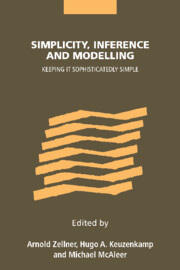Book contents
- Frontmatter
- Contents
- List of figures
- List of tables
- List of contributors
- 1 The enigma of simplicity
- PART I The importance of simplicity
- PART II Simplicity in theory and practice
- 8 Simplicity, information, Kolmogorov complexity and prediction
- 9 Simplicity and statistical inference
- 10 Rissanen's theorem and econometric time series
- 11 Parametric versus non-parametric inference: statistical models and simplicity
- 12 The role of simplicity in an econometric model selection process
- 13 Simplicity in a behavioural, non-parametric context
- 14 Keep it sophisticatedly simple
- 15 Communication, complexity and coordination in games
- 16 The simplicity of an earnings frontier
- 17 Simplicity: views of some Nobel laureates in economic science
- Index
13 - Simplicity in a behavioural, non-parametric context
Published online by Cambridge University Press: 22 September 2009
- Frontmatter
- Contents
- List of figures
- List of tables
- List of contributors
- 1 The enigma of simplicity
- PART I The importance of simplicity
- PART II Simplicity in theory and practice
- 8 Simplicity, information, Kolmogorov complexity and prediction
- 9 Simplicity and statistical inference
- 10 Rissanen's theorem and econometric time series
- 11 Parametric versus non-parametric inference: statistical models and simplicity
- 12 The role of simplicity in an econometric model selection process
- 13 Simplicity in a behavioural, non-parametric context
- 14 Keep it sophisticatedly simple
- 15 Communication, complexity and coordination in games
- 16 The simplicity of an earnings frontier
- 17 Simplicity: views of some Nobel laureates in economic science
- Index
Summary
Motivation
The concept of simplicity is inextricably related to models and the process of modelling (dynamic) phenomena. For that reason, the definition of simplicity critically depends upon the modelling paradigm chosen. In this contribution, we will describe a non-parametric approach to modelling dynamic phenomena, and the role the concept of simplicity plays within that approach. But before turning to the descriptive part, we will first mention the most important sources of inspiration which led us to choose this specific modelling paradigm and the behavioural definition of simplicity that is congruent to it.
The first source of inspiration is to be found in the apparent paradox built into parametric versions of the concept of simplicity, like Schwartz's information criterion, SIC, Akaike's information criterion, AIC, or the minimal description length, MDL (see Keuzenkamp and McAleer, 1995). Concepts such as simplicity, or complexity as its mirror image, are particularly useful in modelling exercises in which economic theory only plays a rather modest role. This type of modelling application is characterized by a lack of economic theory or, just the opposite, by a rich affluence of contradicting economic hypotheses, and puts the data in the forefront when deciding upon the model structure. In so doing it creates a need for principles like Occam's razor. But at the same time, in this type of application with weak theory and strong data, deep structural parameters are scarce, or even absent.
- Type
- Chapter
- Information
- Simplicity, Inference and ModellingKeeping it Sophisticatedly Simple, pp. 227 - 241Publisher: Cambridge University PressPrint publication year: 2002



